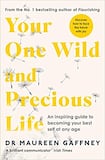
“Who made the world?” Mary Oliver asks in the poem that Maureen Gaffney’s new book takes its title. The speaker is rapt by a grasshopper who has flung herself out of the protection of the grass and is eating sugar from the speaker’s hand, uncamouflaged. This tiny creature takes what she needs, snaps her wings and moves on leaving the speaker to marvel in the miracle of the exchange.
“Tell me, what is it you plan to do with your one wild and precious life?” the speaker ends with. The intimacy of the moment invites the reader to reflect on the divine art of paying attention. In her new book, Your One Wild and Precious Life, Gaffney is advocating the same message: pay attention to where you are, what you want and allow yourself permission to get it.
Attachment theory features heavily in the book. How we become attached to others and why this happens in the way that it does, are some of the questions explored in these pages. For example, if you have an “anxious style” of attachment you “adopt a hyper-activating strategy in response to stress or any perceived threat”.
The stages of how this begins in the preconscious mind and threads its way through a person’s lived experience are tackled in a clear and accessible way. So too is the convoluted way in which you fall in love. Whether you have a secure or insecure attachment style shows up in your romantic and platonic relationships.
I use the word “you” because the book is written in the second person. You are in the position to receive an expertly organised tour through life that maps a wide range of possible outcomes. There is something for everyone within these pages.
The rotund nature of the work makes it feel like a foundational text, accessible to anyone who seeks to know more about themselves and something any trainee psychologist would enjoy. It astutely examines how attachments to people or patterns can speed up, stunt or spark our growth and, most importantly, what we can do about it.
So where can I locate myself in the developmental framework of Gaffney’s new book? As a disabled, queer, non-binary person in their 30s who has a chronic illness, I must work to locate myself within the frame. Eventually, I am floating between late adulthood and old age – disability is not linear. For example, I’ve come much closer to death than to marriage. Mindfulness meditation, which is foundational for my wellbeing, shows up as a tool in that same developmental stage bracket but interacting with it in my teenage years saved my life.
No matter where you locate yourself in this book there’s an energy to the prose that makes it a fascinating read. It challenges us to a moment of revelation: what do you truly want for your one wild and precious life? The message is that no matter what age you are, you still have a choice.
The “SOC strategy” introduced between late adulthood and old age is already part of my lexicon but I call it something else. What does it mean? Select, optimise and compensate. It’s posited as a tool to find one’s purpose in late adulthood but anyone who is chronically ill will immediately recognise this measured analytical approach as something like spoon theory. Spoon theory is when you have only so much energy you must carefully delegate how to spend it. When you must sacrifice something else in order to achieve something else. This is an early developmental tool of the chronically ill. We learn to delegate from day one.
This book is structured in a linear way, from birth to life’s later years with helpful suggestions on how to break out of whatever rut you may be facing. It says we cannot control what happens in life but we can control our response to it and – with the right tools – vanquish our own ingrained trauma cycles. Summary tables at the end of each stage serve as a signal of what accomplishment is expected. Although, surprisingly, the book doesn’t deal in depth with the process of dying like, for example, The Tibetan Book of the Dead. Here there are just one and a half pages dedicated to it. That seems like a lost opportunity. A deeper understanding of death allows for a greater appreciation of life.
But if every love story is a ghost story, as David Foster Wallace says, then Gaffney’s new book resurrects your original love story and the ghosts that it conjures. She provides instructions on how to vanquish the past and understand connection, so a new cycle of living is possible. This book is a powerful reminder that history does not have to dictate our future if we can, somehow, amid the chaos of life, listen now and again. The fundamental question remains: how do we grow in relation to what is happening right here, right now?
Orla Tinsley is author of Salty Baby: My Fight to Live, Love and Laugh










